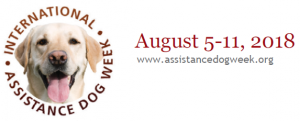
2018 International Assistance Dog Week Fact Sheet
What is it? International Assistance Dog Week was created to recognize all the devoted, hardworking assistance dogs helping individuals mitigate their disability-related limitations
What do assistance dogs do? Assistance Dogs transform the lives of their human partners with debilitating physical and mental disabilities by serving as their companion, helper, aide, best friend and close member of their family.
What are the goals of International Assistance Dog week? The goals are to recognize and honor the hardworking assistance dogs; raise awareness and educate the public about how these specially trained animals are aiding so many people in our communities; honor the puppy raisers and trainers of assistance dogs; and recognize heroic deeds performed by assistance dogs in our communities.
Are all assistance dogs retrievers or are there other breeds as well? Assistance Dogs can be from a variety of breeds including, but not limited to: Labrador Retrievers, Golden Retrievers, Standard Poodles, as well as shelter dogs.
Where can I get more information about Assistance Dogs? You can go to the websites for International Assistance Dog Week (www.assistancedogweek.org) and Working Like Dogs (www.workinglikedogs.com). You can also check out Assistance Dogs International (www.assistancedogsinternational.org) and the International Association of Assistance Dog Partners (www.iaadp.org).
What types of assistance dogs are there? While many people are familiar with Guide Dogs, those that assist people with vision loss, not as many people are aware of the other types of assistance dogs working today. Here is a description of the various types of assistance dogs:
Guide Dogs – Assist people with vision loss, leading these individuals around physical obstacles and to destinations such as seating, crossing streets, entering or exiting doorways, elevators and stairways.
Service Dogs – Assist people with disabilities with walking, balance, dressing, transferring from place to place, retrieving and carrying items, opening doors and drawers, pushing buttons, pulling wheelchairs and aiding with household chores, such as putting in and removing clothes from the washer and dryer.
Hearing Alert Dogs – Alert people with a hearing loss to the presence of specific sounds such as doorbells, telephones, crying babies, sirens, another person, buzzing timers or sensors, knocks at the door or smoke, fire and clock alarms.
Seizure Alert/Seizure Response Dogs – Alert or respond to medical conditions, such as heart attack, stroke, diabetes, epilepsy, panic attack, anxiety attack, post-traumatic stress and seizures.
Medical Alert/Medical Response Dogs – Alert to oncoming medical conditions, such as heart attack, stroke, diabetes, epilepsy, panic attack, anxiety attack, and post-traumatic stress disorder.
Are assistance dogs allowed to go in to restaurants and other businesses even though other pets can’t? Yes, assistance dogs are allowed to accompany their human partners to places of business including restaurants and shops. Under state law and the Americans with Disabilities Act (ADA), they are guaranteed equal access to any and all establishments and accommodations; no extra charge can be levied because of the dog.
Resources:
https://www.assistancedogweek.org/
http://www.serviceanimalassociation.org/service-dog-facts/





 Thankfully, people like Connie Coleman-Lacadie work to prevent non-compliance and help women and minorities attain equal opportunities in the federal workforce. In an interview with GovLoop, Coleman-Lacadie discussed her work as Vice President of Compliance for Federally Employed Women (FEW).FEW’s Efforts for Equality
Thankfully, people like Connie Coleman-Lacadie work to prevent non-compliance and help women and minorities attain equal opportunities in the federal workforce. In an interview with GovLoop, Coleman-Lacadie discussed her work as Vice President of Compliance for Federally Employed Women (FEW).FEW’s Efforts for Equality